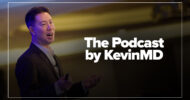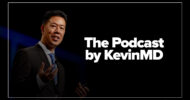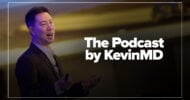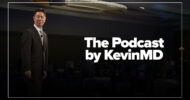Subscribe to The Podcast by KevinMD. Watch on YouTube. Catch up on old episodes!
Pediatrician and certified coach Jessie Mahoney discusses her article “How to get physician wellness programs funded: a proven path forward.” Drawing on nearly two decades of experience navigating institutional hurdles and five years designing wellness programs, she provides a practical roadmap for securing funding. Jessie asserts that funding is possible, countering common skepticism by highlighting diverse funding sources like philanthropy grants, departmental funds, leadership development budgets, and CME dollars. Key strategies include: starting with the belief that funding is attainable, advocating effectively by personally experiencing and embodying the benefits of wellness, engaging leadership by having them participate directly in programs, thinking creatively about funding streams beyond wellness committees, prioritizing high-impact programs led by credible experts over ineffective ones, and considering cost-sharing models. Jessie emphasizes that institutions will fund experiential, connection-focused, and implementable programs that demonstrate tangible change and have leadership support.
Our presenting sponsor is Microsoft Dragon Copilot.
Microsoft Dragon Copilot, your AI assistant for clinical workflow, is transforming how clinicians work. Now you can streamline and customize documentation, surface information right at the point of care, and automate tasks with just a click.
Part of Microsoft Cloud for Healthcare, Dragon Copilot offers an extensible AI workspace and a single, integrated platform to help unlock new levels of efficiency. Plus, it’s backed by a proven track record and decades of clinical expertise—and it’s built on a foundation of trust.
It’s time to ease your administrative burdens and stay focused on what matters most with Dragon Copilot, your AI assistant for clinical workflow.
VISIT SPONSOR → https://aka.ms/kevinmd
SUBSCRIBE TO THE PODCAST → https://www.kevinmd.com/podcast
RECOMMENDED BY KEVINMD → https://www.kevinmd.com/recommended
Transcript
Kevin Pho: Hi, and welcome to the show. Subscribe at KevinMD.com/podcast. Today, we welcome back Jessie Mahoney. She’s a pediatrician and physician coach. Today’s KevinMD article is “How to get physician wellness programs funded, a proven path forward.” Jessie, welcome back to the show.
Jessie Mahoney: Thanks so much for having me.
Kevin Pho: So we were talking offline. You were last on a show about four-plus years ago. Now, for those who didn’t listen to you back then, just briefly share your story and then talk about the KevinMD article.
Jessie Mahoney: Wonderful. As you mentioned, I’m a pediatrician, and I worked at Kaiser, or the Permanente Medical Group, for about 20 years. I was a physician wellness leader there. About five years ago, I pivoted and went off on my own to do physician wellness because I really wanted to be in a position where I could be more nimble. Large organizations want to do so many things, but they are huge container ships and therefore it’s very challenging. So I made the decision to found my own business called Pause and Presence, where, since then, I’ve been doing physician coaching retreats. I give a lot of keynote talks, I have a podcast called The Mindful Healers Podcast, and more recently, I’ve been doing a lot more work circling back to institutions and helping them bring wellness that works to their doctors and teams.
That was really the inspiration for this article. I hear all the time, “There’s no money. We can’t get it. We can’t make it happen. My organization says that they prioritize wellness, but they don’t.” I actually believe that all organizations want to fund wellness; they just don’t know what to do and don’t know what works. We have to make it easy for them by using the right language and showing them things that make a difference.
I thought I would share what had worked for me, especially recently, because I have seen this pattern. I feel like, for physicians out there who really want to make a difference, there is a path that works repeatedly. I thought this article could share that.
Really, what I share in the article for those who didn’t read it, and the key points, are: first, you have to believe it’s possible. Our doctor brain always says, “It’s not possible, it won’t work, they haven’t done it in the past.” Without that belief, you don’t get anywhere. Second, do it yourself. What I’ve found is that the people who have the most success going back and advocating—or helping by getting me to help bring things to their institution—are the ones who’ve done coaching first or come on a retreat first. They come back changed; people see that and see how it’s changed the environment, and then they want to bring it forward.
The other piece then is inviting leadership. So many people share what they did with their leaders and say, “I did this great thing, you should try it.” Their leader may or may not do it, or they themselves may or may not have been a leader, which is often a key piece. But bringing leaders in is really helpful. Even when you get something funded, make sure that your leaders come—and I like to say as participants. Leaders always want to audit or watch from the sidelines. Really getting them to experience it themselves is where you can make things happen.
Once you’re there and you have a program—a program that works, because I think a lot of wellness programs are really just one talk, or they aren’t what I call true wellness—it’s about getting super creative. Very often, people say, “My wellness committee won’t fund this,” or “Wellness funds are limited.” I like to think about wellness as much broader-reaching because wellness fixes retention, so there are HR funds. Wellness improves patient satisfaction and quality of care, so you can find funding in other areas. Speaking the same language as the leaders and helping them solve their own problems is key. I used to be a department chief and physician leader, so it’s really helpful to understand the metrics they have to meet, so you can help them do what they need to do and align your program with those needs.
The last piece, which many people don’t want to do, is to offer to organize it yourself. While it seems like a lot of work, it often isn’t. When you’re working with someone who’s done it or knows how to do it, it’s easier. Many of the people I’ve worked with, who stuck their neck out to bring things back, ended up being promoted and moving into leadership roles they love because they’re bringing something new and showing a different side of themselves. It’s worth your while. If nothing else, you have happier colleagues, and often you gain a role you really enjoy that reawakens your own passion for medicine.
Kevin Pho: So in general, for these wellness programs—legitimate wellness programs—to be instituted, what kind of numbers are we talking about when it comes to cost? What are some of the numbers that some medical organizations are balking at?
Jessie Mahoney: Interestingly, they balk at tiny costs and big costs. It almost doesn’t matter the cost. We’re used to funding things for clinical care, but when leaders hear “wellness,” they get anxious. Sometimes they’ll balk at a talk that’s a couple thousand dollars, and then there are organizations that will pay fifty thousand dollars or have grants that cover it.
One of the best ways is to start small. Then you have a program, you have proof of concept, and you can double it and triple it. Last year, I did a program where we started with 20 doctors. Because there was so much interest, we did another group of 20. Then, based on that feedback, this year we can do 60. Now you have 100 doctors over two years, and while that might seem like it won’t change anything, it does spread out like a ripple.
Sometimes you can split the cost. The organization might pay a deposit, and then physicians pay in to share the cost, and when they see the benefit, they’re willing to fund more. Sometimes we have to decide to put our own skin in the game, which is the power of the people who’ve done it themselves. They usually funded it on their own initially because they wanted to feel better and find something that works. When they return and show how it changed them, it’s much more impactful.
Many of us in medicine—this used to be me too—just want someone else to fix it. We feel we’ve given enough. I know it doesn’t feel good to put more in, but you get so much out of it. Most of us want to stay in medicine; we love medicine. So what can we do to make it better, help our colleagues be healthier, and create a healthier culture?
Kevin Pho: I know there are a lot of variations in terms of what a successful wellness program can look like, but from your experience and from the wellness programs that you implemented, what exactly would that look like? What would a successful program look like?
Jessie Mahoney: If you’re looking at outcomes, it has a long-term impact. It makes long-term change. Often people go to a retreat, feel great for a day, but then go back and within a week they’re in the same situation. I try to bring mindset shifts and new ways of returning so you come back different, even if it’s just from a simple talk.
I think that effective wellness programs focus on agency—physician agency—what you can do, while also acknowledging that the system is broken and needs fixing. My personal belief, and what I see in effective wellness programs, is that they honor those problems. I often talk about Kintsugi pottery, where you’re fixing broken things with gold. That’s what an effective wellness program does. It gives people tools to make themselves stronger, so we can advocate for change or simply keep practicing medicine in the system as it is.
If it doesn’t lead to you feeling different afterward—if you’re not showing up differently—it’s not impactful. That feeling is often at the cellular level. We carry so much trauma from medical training and medical culture in our bodies, and if we don’t teach people how to actually care for themselves and feel what being well is like, it’s just more willpower. The things that truly help make change—coaching, neural rewiring, habit changes—require that you not be in fight or flight. You also can’t be completely depleted, because nobody can change when their basic needs aren’t met.
We also often try to hate ourselves or shame or blame someone, which doesn’t lead to effective change. Programs need to address the physical experience of well-being. That might mean taking people out of the hospital, being in nature, trying all kinds of modalities—because we’re all different. It isn’t that everyone must meditate; they need to find a way to upregulate the parasympathetic nervous system. One of the things I’ve found most helpful is leaning into pathophysiology and neuroscience so people understand the rationale, rather than thinking wellness is “woo” or simply so they can work more.
Kevin Pho: Tell us a story about a wellness program that you have seen or implemented yourself that really moved the needle for the staff and was impactful in some of the measures you mentioned.
Jessie Mahoney: It’s actually the story that inspired this article. Over the last couple of years, I had a client who was a leader, and she did her coaching. She was going to leave her job, and it changed so much that she wanted to stay. She said, “I really want to figure out how to bring this to our organization.” She told me they had a grant; could I help her apply? Together, we wrote a grant application for one event for 20 people, and we got the grant. It had a follow-up component too.
We offered the program, and it filled up in two hours when they sent out an email. Completely full. So we went back and asked for another grant, because there was such a long waiting list. We got a second grant. Based on those two successes, we reapplied for the same grant but asked for more, and we received funding for a bigger program the following year. We also introduced a leadership component, inviting leaders to a workshop explaining what these programs were about and why they should encourage physicians or attend themselves.
We’re in the midst of that, so I’m not sure what the next step is, but that’s how you see these things progress. I’ve seen this pattern time and again: someone experiences the benefit personally and then goes back to advocate for a coaching program or a fellowship program, and they’re more likely to get funding. Interestingly, the funding often comes from different piles of money—GME, philanthropy, patient satisfaction, retention, HR. Every place is different. You just have to find the right pockets. The cost of losing doctors is so high that wellness can be justified. In our grant, this person literally said, “I was going to leave my job, and now I’m staying, and I love it.” That personal story is incredibly powerful for leadership.
In terms of measurement, we sometimes think we need burnout surveys or formal research, which gets expensive. I haven’t done that. I collect written feedback and personal comments, follow up months later, and gather stories about how it helped. If you do this year after year, you build a lot of personal anecdotes. You can ask quick questions in a survey like, “Did you find this worthwhile?” “Do you think it should be offered long term?” A hundred percent of participants might say yes, and that kind of data plus personal comments is very powerful for leadership.
Kevin Pho: We’re talking to Jessie Mahoney. She’s a pediatrician and physician coach. Today’s KevinMD article is “How to get physician wellness programs funded, a proven path forward.” Jessie, let’s end with some take-home messages you want to leave with the KevinMD audience.
Jessie Mahoney: My take-home message is to start with yourself and believe in the possibilities. Instead of thinking about why things won’t work, think about how they could or might. Also remember that wellness is a critical piece of organizational function, so if you can approach it that way, rather than as “woo,” you’ll be much more effective in advocating for programs that work.
Kevin Pho: Jessie, thank you so much for sharing your perspective and insight. Thanks again for coming back on the show.























![A leader's journey through profound grief and loss [PODCAST]](https://kevinmd.com/wp-content/uploads/The-Podcast-by-KevinMD-WideScreen-3000-px-4-190x100.jpg)




